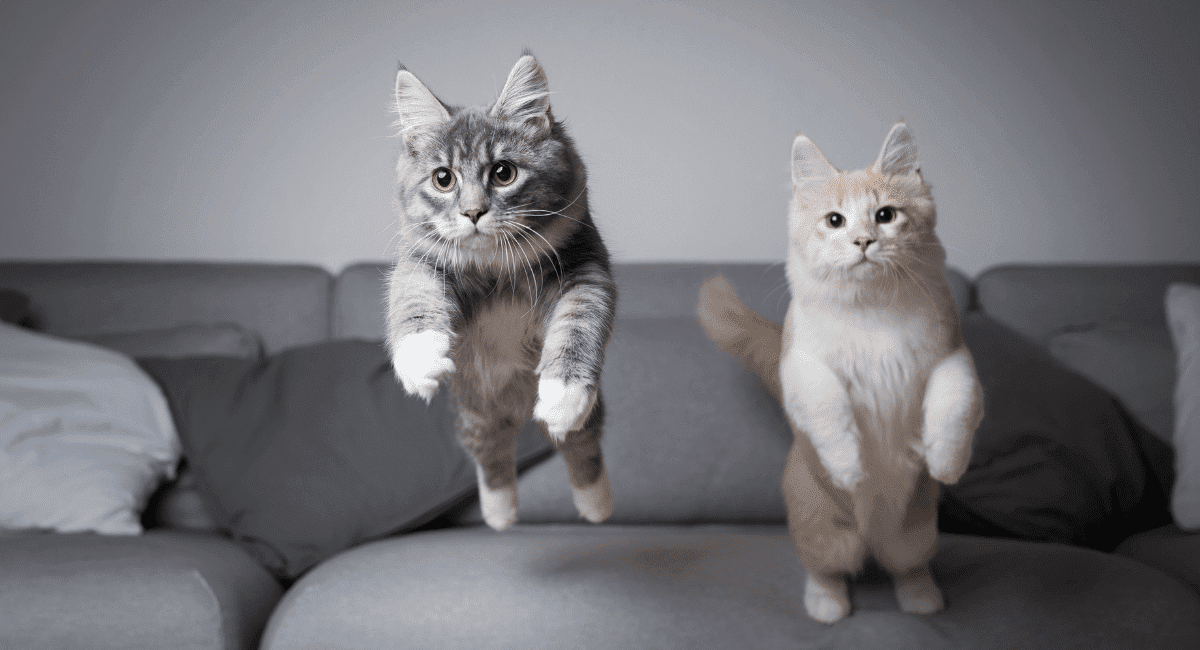If Your Cat Sleeps More Than Leaps, Here are Easy Tips to Get Your Lazy Cat in Shape
Cats sleep around 12-16 hours a day. Between that and a couple of other occasional naps, cats have a reputation for being one of the laziest pets. However, cats shouldn't be as slothful as some may think. If you wonder, “Why is my cat so lazy?” taking action to help them be more active is wise for their physical and mental health. There are many things cat parents may do to help their kitty to be more active.
Table of Contents
Why is my cat so lazy?
As a pet parent, it’s important to be in tune with your cat’s behavior. There are many reasons that a cat can become lazy. To start, cats tend to nap when they are bored. So if you notice your kitty napping quite a bit, that may be why. Cats have more energy when they are mentally stimulated. Basically, your cat might be napping because there isn't anything interesting for them to do.
Another reason you might notice laziness in your cat is because they could be having hip and joint issues. With age, many cats experience hip dysplasia, arthritis, leg sprains, and joint pain. If your cat is significantly less active than normal, you may want to consider that they could be having discomfort in their joints. Our BestLife4Pets Cat Hip & Joint Pain Relief homeopathic Hip and Joint support supplement is specially formulated to relieve your kitty's pain and get them active again in no time. For more information on the challenges your cat may have with aging and how to help them, read our blog on the Top Health Issues of Aging Cats.
Your cat could also be lazier than normal because they are depressed or upset. Cats are very emotionally attentive creatures and change can be a big deal for them. Sometimes, cats will stop being playful and conserve their energy for dealing with stress or anxiety.
There are many different things that can lead to having a depressed cat. But there are other possible reasons such as:
- New pet
- New child
- Moving
- Rearranging your home
- Change in food
- Change in your schedule
These are just a few, but they can all cause your cat to become depressed and therefore a lazy cat.

Are certain cat breeds lazier than others?
Yes, some cat breeds are lazier than others. Having a breed that tends to be a lazy cat means that you will have some work to do to make sure they don't gain too much weight and still get the exercise they need.
Some of the laziest cat breeds include:
- American Shorthair
- Maine Coon
- Persian
- Ragdoll
- Exotic Shorthair
- Scottish Fold
- Russian Blue
What are the health risks involved in cat laziness?
One big health risk for lazy cats is weight gain. Obesity in cats is becoming more common, and one major reason is that a lot of the cats we see in the media are actually overweight. Even if your pet seems healthy, the excess weight can be contributing to early onset of arthritis or even allergies and skin issues. As a cat parent, how can you tell if your cat is a normal weight or could be at risk? Of course your vet will always check your cat's weight, but there is an easy way for you to check for yourself. Here is a quick and easy guide you can use at home to tell if your kitty is at a healthy weight or not.

If your pet is struggling with extra weight, our BestLife4Pets Weight Loss supplement helps overweight pets control hunger and lose weight, relieving joint pain and stress on the organs.
How do I help my lazy cat to exercise?
1. Find toys your lazy cat will actually like
Cat toys are everywhere, but as we all know, cats can be picky. Your cat may not be playing with their toys because the toys may not be interesting to them. So, try some different types. Of course, it can be a challenging quest, but once you find the right one it can keep your cat active.

2. Try some puzzles
There are many different options for cat puzzles out there. There are puzzles that they can do anytime, or battery-operated ones meant to be done with their pawrent around. Test out puzzles that hide their treats or food if they need a little more motivation. A puzzle that they enjoy can keep your lazy cat busy and mentally stimulated with little effort from you.
3. Get an intricate cat tree
Cats are solitary pets and are usually happy with the food, water, and occasional attention. But sometimes they need a little inspiration to become more active; this is where you come in. Playing with your furry friend can help encourage more active behavior, and it can help you bond with your cat. Try a feather or a ball on a string for help. You can also play fetch with your cat if they are willing. So try some different activities with your cat and see what they seem to enjoy the most.
5. Try a supplement for joint problems
If you notice that your cat is slowing down due to joint or hip issues like arthritis or hip dysplasia then, they may not actually be a lazy cat, but are in need of a natural supplement like BestLife4Pets WALK-EASY Hip and Joint Relief Remedy to help with the pain. Cats tend to hide pain well, so you may not be able to notice much of a difference in their behavior.
Is it too late to help my lazy cat to be more active?
In short, no it's not too late. Even older cats can develop healthier habits if you encourage more activity. If your cat is overweight or is already a pretty lazy cat, then it may take longer for them to become as active as you may want. Be patient with them. It's just like humans when we get back to the gym after a long break. We can't usually go there and do the same exercises we did when we were there 5 years ago. Keep that in mind when you're encouraging your furry friend to be more active.

Try the suggestions above to help your cat be more active, but if you notice a significant change in activity or behavior, be sure to consult with a trusted holistic vet. Your vet will be able to guide you on how much exercise your cat should be getting, and they'll be able to give suggestions on making sure your cat is getting enough nutrients in their food.
Have fun playing with your kitty, and encourage more active behavior, and your lazy cat will be more active in no time.



